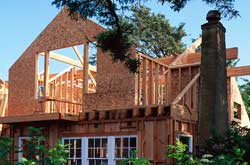The Year of Green
See if We Have Top-Rated
Home Improvement Contractors in Your Area

HomeAdvisor is officially declaring this year the "Year of Green" for the home improvement industry. What is it that's got us thinking in shades of Kermit the Frog during this time of fresh starts and new beginnings? In addition to a rough economy and global climate change, it's the prospect of homeowners saving some hard earned green of their own that has us trumpeting the benefits of green building from the mountaintops. That said, what do you need to know when it comes to green? From basic green remodeling philosophy, to the green projects that stand to benefit you the most, it's time for you to grab a seat, hug a tree, and pay attention. Happy Green Year!
The Basics of Going Green: A Primer
Perhaps the best place to start is pinning down exactly what's so great about green in the first place. Here's a breakdown of the four biggest benefits that green has to offer the average American homeowner:
- Cutting Energy Costs — Energy savings are the number one reason homeowners go green. Green remodeling utilizes things like passive solar heating, day lighting, maximizing insulation levels, high efficiency replacement windows, and installing high efficiency heating and cooling systems, in order to drastically reduce your home's energy usage. The result: annual savings that can add up to hundreds, and even thousands, of dollars.
- Reducing Waste — Drafty doors and windows aren't the only place that wasteful building practices affect homeowners. Reducing waste in all other areas of a building project saves money as well. By recycling landscaping and construction waste, reusing building materials that are in good shape, such as doors, windows, and even lumber, and building with recycled products or products made from recycled content, you'll be able to cut your materials costs, and help cut the amount of waste that ends up in our nation's landfills as well.
- Creating Healthy Living Environments — Few homeowners realize it, but many of the building products commonly used in American homes have been linked to health problems as diverse as asthma, cancer, and even nervous system disorders, just to name a few. Green building seeks to reduce these potential health threats by using healthy building materials whenever possible, and by making sure to provide adequate ventilation so that indoor air quality problems don't reach such harmful levels in the first place.
- Protecting the Environment — Finally, there's protecting the environment. To be honest, it doesn't matter how safe, healthy, and energy efficient our homes are, if we're causing serious environmental harm on a global scale. Green building and remodeling seeks to reduce our negative impacts on the environment through responsible logging practices, reducing our carbon footprints, reducing landfill waste, promoting the use of recycled and reusable materials, and reducing our reliance on fossils fuels.
Make your home energy efficient! Use this link for
Heating & Cooling
A Green Game Plan for Homeowners
Getting to know green is important. Actually going green is another story altogether. If you're starting to think that green is the right choice for you, here's a simple three step plan to get you and your home moving in a green direction.
- #1. Start Small — Nobody's suggesting that you start by tearing down your existing home and building it back up with old tires and straw bales (though if you knew how energy efficient those homes are, you might give it a second thought!). Instead, start simple. Replace incandescent light bulbs with CFLs, install inexpensive low flow fixtures at sinks and showers, and caulk, seal, and weatherstrip your home to increase its overall energy efficiency.
- #2. Thinking Bigger — When you start noticing the difference that those simple, and inexpensive, green upgrades in Step 1 make when it comes to energy savings and improving your home's comfort level, you might decide you're ready to move to the next level of green. Purchasing a high efficiency furnace and air conditioner, installing energy star appliances, and making modest upgrades like adding insulation or installing high efficiency replacement windows, might cost more up front than a few CFLs, but when you look at long term savings you'll quickly realize that these green investments are paying for themselves as the years roll by.
- #3. The Whole Banana — Honestly, there might another two or three steps between "Thinking Bigger" and "The Whole Banana," but for the sake of our green game plan, it's time to hold your breath and jump in the deep end. The greenest home is a home built green from the ground up, from the concrete used to pour its foundation right on up to the roofing material, and everything in between. Sound extreme? It's not. Give the home improvement industry a few years to fully co-opt a green mindset, and our prediction is that what we're calling "green" now is going to be standard operating procedure just a few years down the road. After all, when you're talking safer, more comfortable, more energy efficient, healthier, and more responsibly built homes, is there any other option?
The time is now. The color is green. This is the Year of Green. You heard it here, in the neighborhood, first.
More Tips & Advice For Your Home
- Related Articles
- Recent Articles

